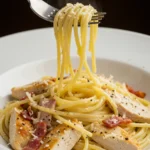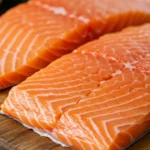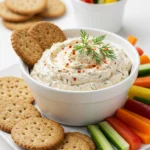Follow Me On Social Media!
fish batter recipe
Introduction: The Quest for the Perfect Crunch
Picture this: you’re at your favorite fish and chips shop, and that first bite delivers the most satisfying crunch followed by tender, flaky fish inside. Now imagine biting into homemade fried fish only to find a soggy, greasy mess that falls apart before it reaches your mouth. I’ve been there, and honestly, it’s heartbreaking.
But here’s the thing – achieving that restaurant-quality fish batter recipe at home isn’t some culinary mystery reserved for professional chefs. With the right technique and a few insider secrets, you can create crispy, golden perfection in your own kitchen every single time.
In this comprehensive guide, I’ll walk you through everything you need to know about creating the perfect batter. We’ll cover the science behind why certain ingredients work, share my foolproof master recipe, explore delicious variations, and troubleshoot common problems. By the end, you’ll have all the tools to become your family’s fried fish hero.
Table of Contents
The Science of a Flawless Fish Batter
Understanding the “why” behind great batter makes all the difference in your results. Let me break down the key scientific principles that create that perfect crunch.
The Role of Leavening Agents Leavening agents like baking powder, baking soda, beer, or sparkling water are your secret weapons for creating light, airy texture. These ingredients release carbon dioxide bubbles when mixed with liquid, creating tiny air pockets throughout the batter. When the batter meets hot oil, bubbles rapidly expand, forming the light, crispy coating we crave instead of a dense one.
Temperature Matters More Than You Think Here’s where many home cooks go wrong – temperature control. Cold batter meeting hot oil (around 350-375°F) creates an immediate reaction that seals the exterior while keeping the interior light. If the oil is too cool, the batter will soak up grease and turn soggy. If it’s too hot, the outside will burn before the inside cooks through.
The Flour Factor Different flours bring unique properties to your batter. All-purpose flour provides structure and body, while cornstarch adds extra crispiness by creating a more delicate coating. Rice flour, popular in tempura-style batters, creates an incredibly light and crispy texture that stays crunchy longer.
The Ultimate Crispy Fish Batter Recipe (Our Signature Method)
Print
The Ultimate Fish Batter Recipe: Your Guide to Perfect Crispy Fish
- Total Time: 25 minutes
- Yield: 4–6 servings 1x
Description
Learn how to make the perfect crispy fish batter that creates a golden, light coating every time. This foolproof recipe uses simple ingredients to achieve restaurant-quality results at home with a deliciously crunchy exterior and tender fish inside.
Ingredients
- 1 cup (125g) all-purpose flour
- ¼ cup (30g) cornstarch
- 1 teaspoon baking powder
- 1 teaspoon salt
- ½ teaspoon garlic powder
- ¼ teaspoon black pepper
- 1 cup (240ml) cold sparkling water or club soda
- 1 large egg, cold
- 1 tablespoon vegetable oil
- 2–3 pounds (900g-1.4kg) firm white fish fillets (cod, haddock, or tilapia)
- Vegetable oil for deep frying
- Extra flour for dredging
Instructions
- Pat fish fillets completely dry with paper towels. Cut into serving-sized pieces and season lightly with salt.
- Heat oil in a heavy-bottomed pot to 375°F (190°C).
- Whisk together all dry ingredients in a large bowl. In separate bowl, beat egg, then whisk in cold sparkling water and oil.
- Pour wet ingredients into dry ingredients and whisk just until combined – lumps are okay.
- Dredge fish pieces in flour, then dip in batter, allowing excess to drip off.
- Fry 3-4 pieces at a time for 3-4 minutes until golden brown and crispy.
- Transfer to wire rack and serve immediately.
Notes
- Keep batter cold for best results
- Don’t overmix the batter – lumps are fine
- Maintain oil temperature at 375°F for optimal crispiness
- Pat fish completely dry before coating
- Use a wire rack for draining to prevent sogginess
- Best served immediately while coating is crispy
- Prep Time: 10 minutes
- Cook Time: 15 minutes
- Category: Main Dish
- Method: Deep Frying
- Cuisine: American/British
Nutrition
- Serving Size: 1 piece (approximately 5 oz fish with batter)
- Calories: 285
- Sugar: 1g
- Sodium: 520mg
- Fat: 12g
- Saturated Fat: 2g
- Unsaturated Fat: 9g
- Trans Fat: 0g
- Carbohydrates: 18g
- Fiber: 1g
- Protein: 28g
- Cholesterol: 95mg
Keywords: fish batter recipe, crispy fish batter, easy fish batter recipe, how to make fish batter, fried fish recipe, beer batter alternative, homemade fish and chips, crispy coating for fish
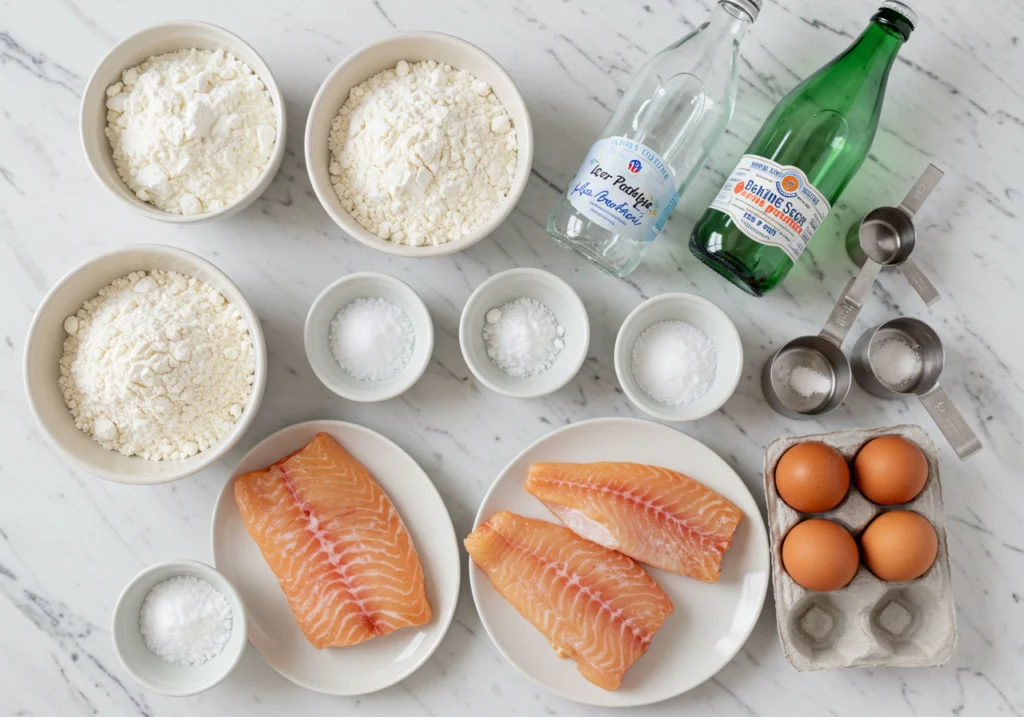
Step-by-Step Instructions
Step 1: Prepare Your Fish Pat fish fillets completely dry with paper towels. Cut into serving-sized pieces, about 4-5 inches long. Season lightly with salt and set aside.
Step 2: Heat the Oil Fill a deep, heavy pot or fryer with enough oil to let the fish move around easily. Warm it until it reaches 375°F (190°C) before adding anything.
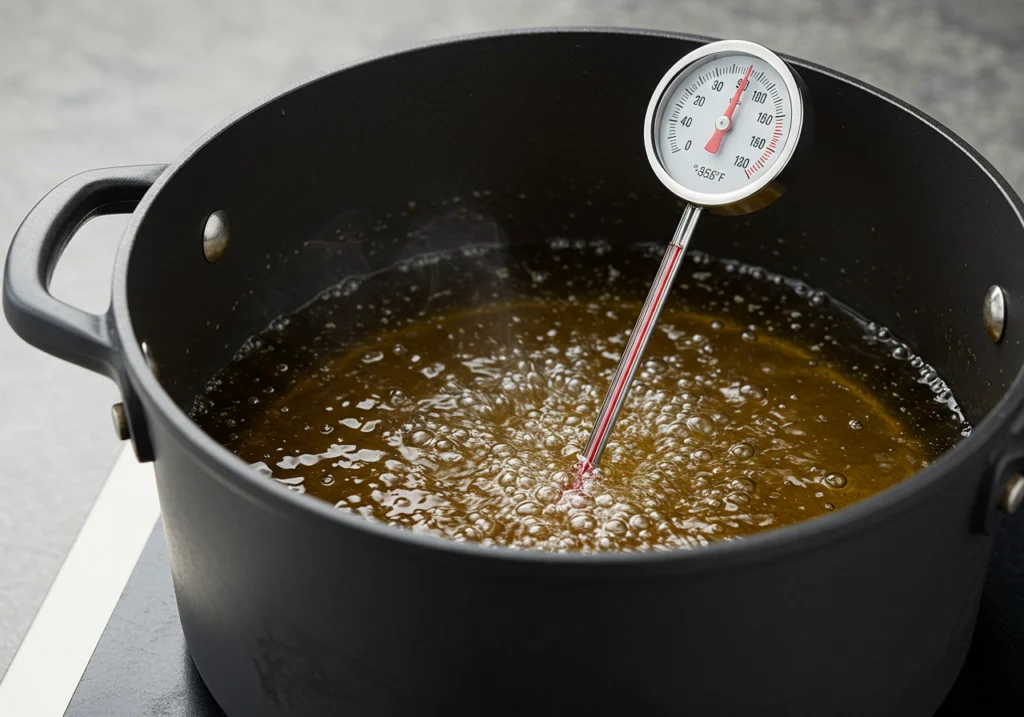
Step 3: Make the Batter In a large bowl, whisk together all dry ingredients. In a separate bowl, beat the cold egg, then whisk in sparkling water and oil. Pour wet ingredients into dry ingredients and whisk just until combined – lumps are okay! The batter should have the consistency of thin pancake batter.

Step 4: Dredge and Dip Place extra flour in a shallow dish. Dust the fish pieces with a thin layer of flour, then shake off the excess. Then dip them into the batter, letting the extra batter drip away.

Step 5: Fry to Golden Perfection Gently place the battered fish into hot oil. Cook in small batches of 3–4 pieces to avoid overcrowding. Cook for 3–4 minutes, or until the coating turns golden brown and delightfully crisp. Using a slotted spoon, transfer onto a wire rack.

Step 6: Serve Immediately Enjoy while hot, paired with your favorite sides, so the coating stays perfectly crispy.
Essential Tips for Batter Success: Your Questions Answered
How to Make the Batter Stick
The most frequent complaint I hear is, ‘My batter keeps sliding off!” Here’s how to fix that:
Dry the fish well with paper towels before cooking—excess moisture will prevent the batter from sticking properly. Even a little surface water will prevent proper adhesion. Lightly coat the fish with plain flour before covering it in batter. The flour layer functions like adhesive, providing the batter with something to cling to.
Avoiding Soggy Batter
Nothing ruins fried fish like a soggy coating. Follow these non-negotiable rules:
Maintain your oil temperature between 350-375°F. Invest in a good thermometer – guessing doesn’t work. Never overcrowd your pan, as this drops the oil temperature instantly. Finally, drain fried fish on a wire rack, not paper towels. Paper towels trap steam, making your crispy coating soggy.
Choosing the Best Fish for Frying
Not all fish are created equal for frying. Opt for solid, white-fleshed fish like cod, haddock, tilapia, or pollock. These varieties have mild flavors that won’t compete with your batter, and their firm texture holds up well during frying without falling apart.
Getting the Right Batter Consistency
Your batter should coat the back of a spoon but still drip off easily – think thin pancake batter. Too thick? Add more sparkling water, one tablespoon at a time. Too thin? Whisk in a little more flour gradually.
Recipe Variations: Customize Your Crunch
The Ultimate Beer Batter
Replace sparkling water with 1 cup of light lager or pilsner. The beer’s carbonation creates lift while adding subtle malty flavor. Let this batter rest for 10 minutes before using – the beer needs time to activate with the flour.
No Beer? No Problem! (Crispy Batter without Alcohol)
This easy fish batter recipe uses club soda instead of beer for the same lifting effect without alcohol. Add 1 teaspoon of sugar to compensate for beer’s natural sugars, which help with browning.
The Best Gluten-Free Fish Batter
Substitute all-purpose flour with an equal amount of a gluten-free 1:1 flour blend. Add an extra 2 tablespoons of cornstarch for superior crispiness. Rice flour works wonderfully in gluten-free batters – try replacing half the gluten-free flour with rice flour for incredibly light results.
Spicy Fish Batter
Kick up the heat by adding 1 teaspoon cayenne pepper, 2 teaspoons smoked paprika, or 1 tablespoon of your favorite hot sauce to the wet ingredients. The spice adds complexity without overwhelming the fish’s delicate flavor.
Ideal Complements: Serving Suggestions for Your Fried Fish
Classic Sides
Homemade Tartar Sauce
- ½ cup mayonnaise
- 2 tablespoons sweet pickle relish
- 1 tablespoon fresh lemon juice
- 1 teaspoon capers, chopped
- Salt and pepper to taste
Combine all ingredients and refrigerate for a minimum of 30 minutes before serving.
Crispy French Fries: Slice russet potatoes into thick strips, soak them in cold water for 30 minutes, then double-fry for maximum crispiness.
Classic Coleslaw The crisp, creamy coleslaw offers a refreshing contrast to the warmth and crunch of crispy fish.

Other Serving Suggestions
Turn your fried fish into delicious fish tacos with soft, warm tortillas, crisp cabbage slaw, and zesty lime crema. Or build the ultimate fish sandwich with toasted brioche, fresh lettuce and tomato, and rich homemade tartar sauce.
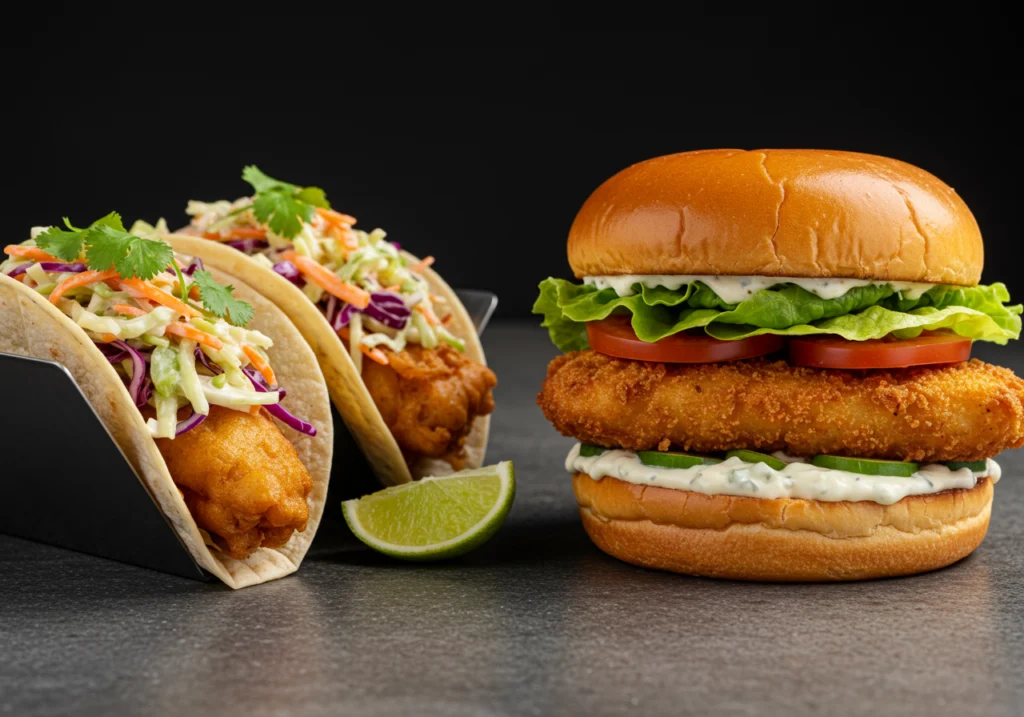
Frequently Asked Questions
Can I make the batter ahead of time? It’s best to use batter immediately for maximum lift and crispiness. If you must prepare ahead, make it no more than 30 minutes in advance and give it a gentle stir before using.
Can I bake or air-fry battered fish? While you can try, the results won’t match deep-fried fish. Baking at 450°F or air-frying at 400°F for 12-15 minutes can work, but expect less crispiness.
What’s the best oil for frying fish? Use neutral oils with high smoke points like vegetable oil, canola oil, or peanut oil. Avoid olive oil, as it has a low smoke point and strong flavor.
What’s the best way to store and reheat leftover fried fish? Keep refrigerated for up to 3 days. Reheat in a 400°F oven for 5-7 minutes to restore crispiness – never use the microwave.
Conclusion: Your Journey to Fried Fish Mastery
Perfecting a fish batter recipe depends on several essential techniques: maintaining a cold batter, heating the oil to the correct temperature, dredging the fish correctly, and carefully regulating the cooking heat. With this ultimate recipe and tried-and-true techniques, you’ll be able to make restaurant-quality fried fish that will wow family and friends.
The beauty of this recipe lies in its reliability – follow the steps, and you’ll get consistent, crispy results every time. Once you’ve mastered the basics, feel free to explore different variations.
Ready to dive in? Give this recipe a try this weekend and tell us how it goes in the comments! Share your crispy creations on social media and tag us – I can’t wait to see your delicious results.
Remember, great fried fish isn’t about luck – it’s about technique. Now you have both the knowledge and the recipe to make it happen. Happy frying!

